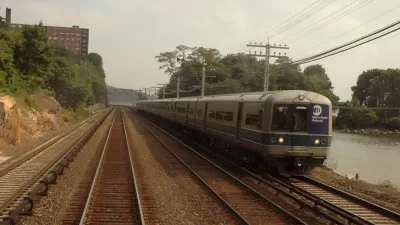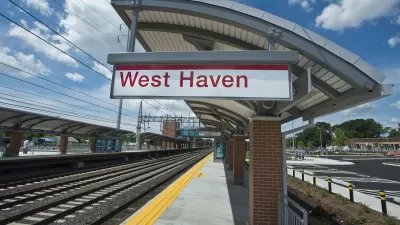Though Connecticut is well served by commuter rail, a new report indicates that only half of the communities with Metro-North station have land use regulations in place to maximize development around them.
"Despite the seemingly obvious advantages of TOD, only about half the Connecticut communities along the Metro-North New Haven Division rail line have adopted plans to foster development around their railroad stations," says a recent study released by the Regional Plan Association.
"Only 50 percent of station areas allow the kind of construction densities appropriate to transit-served neighborhoods, those with a mix of homes, stores and services within walking distance of transit. Finally, only 19 percent of stations have parking regulations that 'acknowledge the ability of TOD to reduce the need for parking ... through improved transit and walkability,' the study says."
"A train station surrounded by a vast sea of asphalt is not what we are looking for here," adds the editors of The Hartford Courant. "Connecticut has a choice. The state can keep building low-density suburban sprawl, until we (shortly) run out of open land, or we can build denser urban communities around transit — to create vibrancy, save energy, reduce pollution, improve the housing mix and take pressure off the dwindling green space. It is a moment for TOD."
FULL STORY: Towns Should Build On Their Transit Stops

Study: Maui’s Plan to Convert Vacation Rentals to Long-Term Housing Could Cause Nearly $1 Billion Economic Loss
The plan would reduce visitor accommodation by 25,% resulting in 1,900 jobs lost.

Alabama: Trump Terminates Settlements for Black Communities Harmed By Raw Sewage
Trump deemed the landmark civil rights agreement “illegal DEI and environmental justice policy.”

Why Should We Subsidize Public Transportation?
Many public transit agencies face financial stress due to rising costs, declining fare revenue, and declining subsidies. Transit advocates must provide a strong business case for increasing public transit funding.

Paris Bike Boom Leads to Steep Drop in Air Pollution
The French city’s air quality has improved dramatically in the past 20 years, coinciding with a growth in cycling.

Why Housing Costs More to Build in California Than in Texas
Hard costs like labor and materials combined with ‘soft’ costs such as permitting make building in the San Francisco Bay Area almost three times as costly as in Texas cities.

San Diego County Sees a Rise in Urban Coyotes
San Diego County experiences a rise in urban coyotes, as sightings become prevalent throughout its urban neighbourhoods and surrounding areas.
Urban Design for Planners 1: Software Tools
This six-course series explores essential urban design concepts using open source software and equips planners with the tools they need to participate fully in the urban design process.
Planning for Universal Design
Learn the tools for implementing Universal Design in planning regulations.
Smith Gee Studio
Alamo Area Metropolitan Planning Organization
City of Santa Clarita
Institute for Housing and Urban Development Studies (IHS)
City of Grandview
Harvard GSD Executive Education
Toledo-Lucas County Plan Commissions
Salt Lake City
NYU Wagner Graduate School of Public Service





























